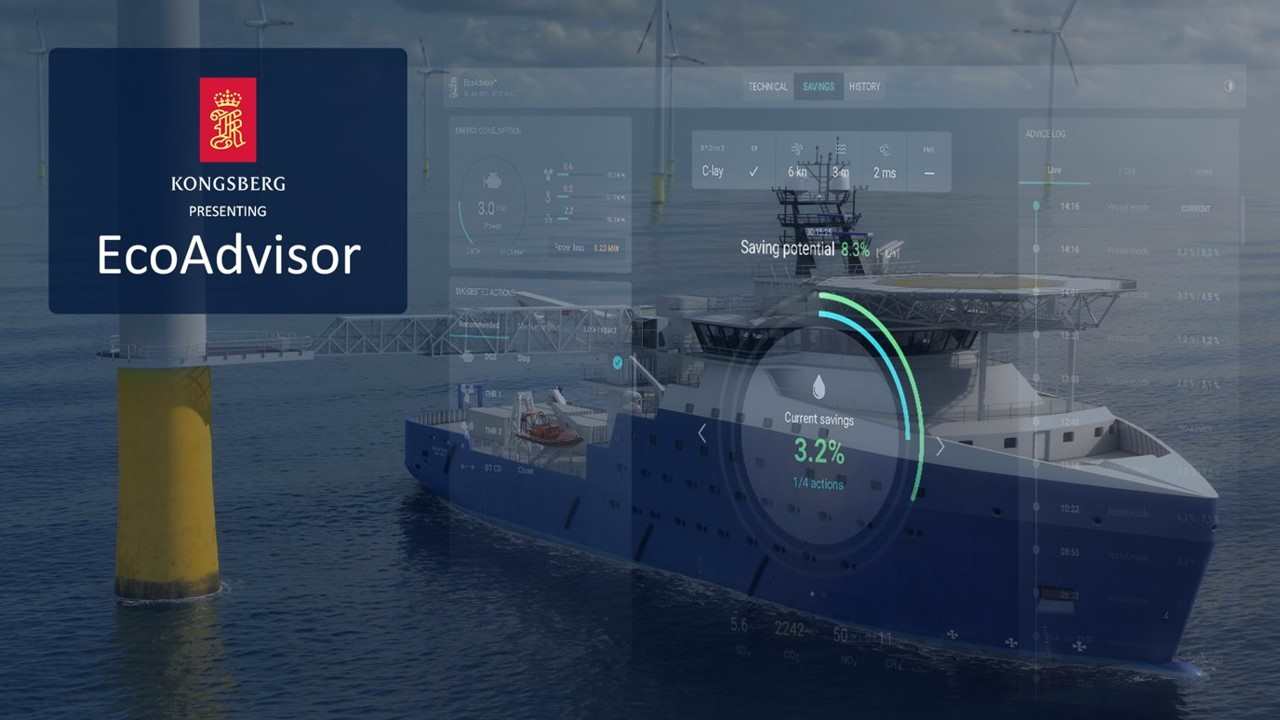EcoAdvisor™ is an outcome of a joint ‘Intelligent Efficiency’ research project between Kongsberg Maritime, vessel operator DOF Subsea AS (DOF), Sintef, NORCE and Innovation Norway, with the aim of developing technologies to monitor and reduce the GHG (greenhouse gas) emissions during vessel operations.
EcoAdvisor™ monitors the vessel operation and its environment, including power generation, propulsion, environmental forces and control system dynamics. EcoAdvisor™ enables operators to achieve reductions in fuel, emissions and maintenance costs, without compromising vessel redundancy margins or vessel operational efficiency.
With stricter regulations and a global need for industry to operate as sustainably as possible, EcoAdvisor™ provides live advice on how ship owners can reduce their carbon footprint whilst at the same time reducing OPEX.
“EcoAdvisor™ demonstrates clearly how a decision support tool relying on the power of digitization can help vessel operators remain competitive in a growing green market. Several factors contribute to inefficiencies in maritime operations, such as multiple engines running at low utilisation, load variations, and large power fluctuations due to mission equipment and thrusters. Vessel owners have found it challenging to achieve sustainable operations due to conservative requirements from charters and a lack of a holistic overview of their operations.” Odd Hagen, VP Offshore Sales, Kongsberg Maritime.
“EcoAdvisor™ creates an intelligent and comprehensive overview of all these factors, delivering advice that enables efficient, cost-effective and sustainable solutions to be made without compromising vessel redundancy margin. Further, the history log and reporting functions in EcoAdvisor™ can be used to determine the Energy Efficiency Existing Ship Index
(EEXI), the Energy Efficiency Operational Indicator (EEOI) and Carbon Intensity Indicator (CII) to ensure compliance with the IMO.”
EcoAdvisor™ works by collecting and analysing real-time data from various systems onboard. These include dynamic positioning (DP), integrated automation systems (IAS), navigation and power management systems (PMS). This data is passed through a non-linear optimisation solver to find the optimal set up of the power plant for the current environmental conditions, considering the demand from various consumers including thrusters, mission equipment and hotel loads. The optimal load reference for engines and state of charge reference for batteries is computed based on their efficiency and power loss.
Based on this analysis, operational advice is provided to the Captain, DP operator and Chief Engineer as to what machinery (engines, batteries and thrusters) can be stopped to run the vessel more efficiently and sustainably. This advice is dynamic – if a change in the mean weather conditions (wind, wave and current), power plant system or DP system settings is detected, EcoAdvisor’s recommendations will be revised accordingly. All advice is backed up by a system overview indicating why these changes are desirable, how any steps will alter the balance between efficiency and redundancy margin, and what the real-time effect of the measures are.
EcoAdvisor™ includes a Voyage Energy Calculator (VEC) feature for transit operation. This helps the operator to determine the total energy consumption for varying speed profiles including added resistance due to wind, wave and current for selected routes based on the weather forecast. This allows operators to decide the optimal speed with minimum fuel energy consumption for a specific trip, according to their departure/arrival time requirements.
Utilizing EcoAdvisor’s innovative features on the optimisation of the use of generators, thrusters, and the setup of the power plant, while maintaining and ensuring safety during DP operations, DOF currently has ‘Intelligent Efficiency’ pilot schemes running on two vessels (Skandi Vega & Skandi Africa) and are expecting positive data from these.
“We see there is potential for both savings and reduction of greenhouse gas emissions, and if the result from the pilot vessels is as expected, we anticipate that this will be installed on a larger part of our fleet”,
Arnstein Kløvrud SVP Technology & Integrated Solutions at DOF
























